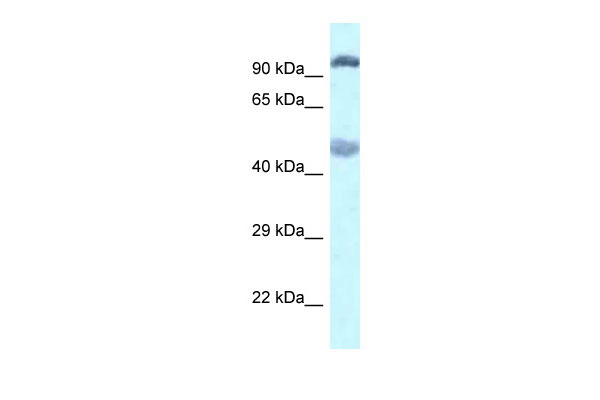Egln2 antibody - C-terminal region
Rabbit Polyclonal Antibody
- 产品详情
- 实验流程
Application
| WB |
|---|---|
| Primary Accession | Q6AYU4 |
| Other Accession | NM_001004083, NP_001004083 |
| Reactivity | Human, Mouse, Rat, Rabbit, Zebrafish, Dog, Horse, Bovine |
| Predicted | Mouse, Rat, Pig, Horse, Bovine |
| Host | Rabbit |
| Clonality | Polyclonal |
| Calculated MW | 44681 Da |
| Gene ID | 308457 |
|---|---|
| Alias Symbol | MGC93662, MGC93666, PHD-1, PHD1, HPH-1, HPH-3, HIF-PH1 |
| Other Names | Egl nine homolog 2, 1.14.11.29, HPH-3, Hypoxia-inducible factor prolyl hydroxylase 1, HIF-PH1, HIF-prolyl hydroxylase 1, HPH-1, Prolyl hydroxylase domain-containing protein 1, PHD1, Egln2 |
| Format | Liquid. Purified antibody supplied in 1x PBS buffer with 0.09% (w/v) sodium azide and 2% sucrose. |
| Reconstitution & Storage | Add 50 ul of distilled water. Final anti-Egln2 antibody concentration is 1 mg/ml in PBS buffer with 2% sucrose. For longer periods of storage, store at 20°C. Avoid repeat freeze-thaw cycles. |
| Precautions | Egln2 antibody - C-terminal region is for research use only and not for use in diagnostic or therapeutic procedures. |
| Name | Egln2 {ECO:0000312|RGD:631376} |
|---|---|
| Function | Prolyl hydroxylase that mediates hydroxylation of proline residues in target proteins, such as ATF4, IKBKB, CEP192 and HIF1A (PubMed:15925519). Target proteins are preferentially recognized via a LXXLAP motif (By similarity). Cellular oxygen sensor that catalyzes, under normoxic conditions, the post-translational formation of 4- hydroxyproline in hypoxia-inducible factor (HIF) alpha proteins (PubMed:15925519). Hydroxylates a specific proline found in each of the oxygen-dependent degradation (ODD) domains (N-terminal, NODD, and C- terminal, CODD) of HIF1A (By similarity). Also hydroxylates HIF2A (By similarity). Has a preference for the CODD site for both HIF1A and HIF2A (By similarity). Hydroxylated HIFs are then targeted for proteasomal degradation via the von Hippel-Lindau ubiquitination complex (By similarity). Under hypoxic conditions, the hydroxylation reaction is attenuated allowing HIFs to escape degradation resulting in their translocation to the nucleus, heterodimerization with HIF1B, and increased expression of hypoxy-inducible genes (By similarity). EGLN2 is involved in regulating hypoxia tolerance and apoptosis in cardiac and skeletal muscle (By similarity). Also regulates susceptibility to normoxic oxidative neuronal death (By similarity). Links oxygen sensing to cell cycle and primary cilia formation by hydroxylating the critical centrosome component CEP192 which promotes its ubiquitination and subsequent proteasomal degradation (By similarity). Hydroxylates IKBKB, mediating NF-kappa-B activation in hypoxic conditions (By similarity). Also mediates hydroxylation of ATF4, leading to decreased protein stability of ATF4 (By similarity). |
| Cellular Location | Nucleus. |
| Tissue Location | Expressed in heart, kidney, brain, liver, skeletal muscle, lung and spleen. Highest level in testis |
Research Areas
For Research Use Only. Not For Use In Diagnostic Procedures.
Application Protocols
Provided below are standard protocols that you may find useful for product applications.
终于等到您。ABCEPTA(百远生物)抗体产品。
点击下方“我要评价 ”按钮提交您的反馈信息,您的反馈和评价是我们最宝贵的财富之一,
我们将在1-3个工作日内处理您的反馈信息。
如有疑问,联系:0512-88856768 tech-china@abcepta.com.























 癌症的基本特征包括细胞增殖、血管生成、迁移、凋亡逃避机制和细胞永生等。找到癌症发生过程中这些通路的关键标记物和对应的抗体用于检测至关重要。
癌症的基本特征包括细胞增殖、血管生成、迁移、凋亡逃避机制和细胞永生等。找到癌症发生过程中这些通路的关键标记物和对应的抗体用于检测至关重要。 为您推荐一个泛素化位点预测神器——泛素化分析工具,可以为您的蛋白的泛素化位点作出预测和评分。
为您推荐一个泛素化位点预测神器——泛素化分析工具,可以为您的蛋白的泛素化位点作出预测和评分。 细胞自噬受体图形绘图工具为你的蛋白的细胞受体结合位点作出预测和评分,识别结合到自噬通路中的蛋白是非常重要的,便于让我们理解自噬在正常生理、病理过程中的作用,如发育、细胞分化、神经退化性疾病、压力条件下、感染和癌症。
细胞自噬受体图形绘图工具为你的蛋白的细胞受体结合位点作出预测和评分,识别结合到自噬通路中的蛋白是非常重要的,便于让我们理解自噬在正常生理、病理过程中的作用,如发育、细胞分化、神经退化性疾病、压力条件下、感染和癌症。






